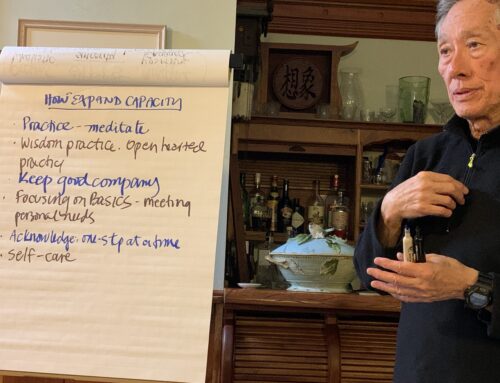
There is understandably a lot of fear surrounding the current pandemic. But what is fear, and is there a way to mitigate it?
To understand fear, you may want to try this little thought experiment: imagine you were completely present—only experiencing this moment, and incapable of having any thoughts of the past or the future. Now, imagine you’re walking through the woods, and you come face-to-face with a big ol’ bear. If you could not foresee the bear attacking you, and you had no memory informing you that it could, who—and how—would you be in that moment? Would you panic and run? Would you freeze up? Would you start yelling and attacking the bear? Or would you simply be curious?
Remember, you have no idea that this creature (or anything) can hurt you. You probably don’t even know what this big furry thing in front of you is. You see its big teeth and huge clawed hands. You may hear it growl. And all you can do in this imagined state is experience things as they are.
When I sit with this thought experiment, I only see myself as curious. Fear does not arise because I have no reason to be fearful. I have no tools to imagine what might happen.
Now, of course, this is the very reason why we have a fear response! Without it, our ancestors would have died long before they could have reproduced, and you wouldn’t be here reading this because our species would have died off many, many millennia ago.
So the fear response is very useful, and something we should all be grateful for possessing. However, it only really serves us in those moments we need to react to a situation—you know, like when we’re face-to-face with a bear. The rest of the time it can be a bit of a hindrance. When we’re in fear, our rational mind tends to shut down while our fearful one takes over, and our problem solving tends to devolve to a choice between attacking, running, or freezing up.
In the midst of a pandemic there will be a lot of fear. And with a lot of fear, we can expect a lot of irrationality. It is imperative, therefore, that as many of us as possible minimize our fearfulness and approach this situation as clear-headedly as possible.
But how do we do this?
Think back to the bear. What prevented the fear? It was the superhuman ability to remain present, and not be hindered by thoughts of the past or future. Presence is always a good antidote for fear.
Great. I’m experiencing fear and you’re just telling me to be present. How can I be present if I’m in fear?
While this looks like a Catch-22 scenario, it really isn’t. Fear provides us some excellent opportunities to practice presence because it can be so powerful. One way to become more present when experiencing strong emotions is to observe those emotions, with curiosity and without judgment (as best as possible under the circumstances, anyway). Here are some things to observe:
- Bodily sensations: What do you notice in your body? Is there tension? Where? What does it feel like? Does the experience of tension change as you observe it? What do you notice in your belly? In your face? Are your hands clenched? What does that feel like? Notice your forehead. Can you feel your heart beating? What other sensations are present? Allow your attention to shift as different sensations become more or less evident.
- Breathing: Just notice your breathing as it does its thing. Allow it to continue to do its thing, and notice whether anything changes in your breathing as you observe it. If it does change, simply allow that to happen too.
- Thoughts: Invite your thoughts to flow freely. Every time one arises, give it a name—perhaps planning, or memory, or catastrophizing, or need to know, or uncertainty, or even thought. Every time you name a thought, just let it be and await the next one. If it returns, name it again (with the same or a different name), and await the next one.
All of these activities—and any other mindfulness tools you may possess—are designed to bring us into presence. Fear and presence cannot exist in the same space.
When you have given yourself the opportunity to approach presence through these methods, and found a degree of stillness as a result, spend a few moments asking yourself, how am I now? This is always a good question to ask, and it can be difficult to answer when our minds are off somewhere that decidedly isn’t now. So the trick is to first return to now, and then check-in: how am I now?
And none of this is to say you shouldn’t be concerned. It’s not to say you shouldn’t prepare for the worst. It is just to give yourself some freedom in uncertain times. Fear is a prison, and you cannot be effective when you’re walled off from the world.
No matter how dire your circumstances are now (or appear to be in the future), your perception of them can make them a whole lot worse. By being present with them, you can see things as they are, and act as effectively as possible in that particular situation.
May you be well. May you be free from harm.



